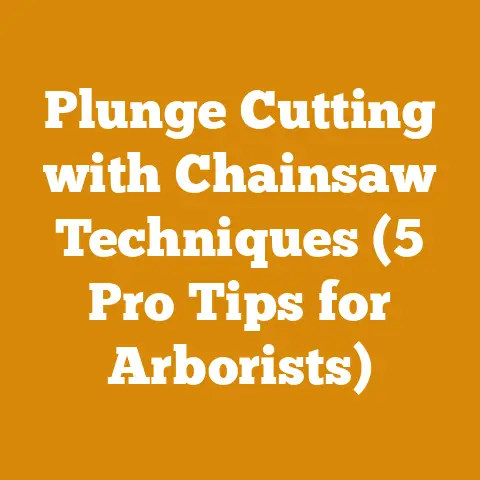Brush Bandit 200XP Chipper Tips (5 Pro Arborist Secrets)
Ever wrestled with a wood chipper, feeling like you’re in a battle against nature itself? I know I have. Over the years, I’ve spent countless hours feeding wood into the hungry maw of various chippers, and the Brush Bandit 200XP has become a trusted ally. It’s a beast, no doubt, but like any powerful tool, it demands respect and a bit of know-how to truly unlock its potential. So, are you ready to transform your brush piles into manageable mulch with the efficiency and safety of a seasoned pro? Let’s dive into my top five arborist secrets to mastering the Brush Bandit 200XP.
Brush Bandit 200XP Chipper Tips (5 Pro Arborist Secrets)
1. The Art of the Feed: Mastering Material Presentation
Forget just chucking branches into the chipper and hoping for the best. The way you feed the Brush Bandit 200XP is paramount to its performance and your safety. This isn’t just about speed; it’s about strategy. I’ve seen firsthand how a thoughtful approach can drastically reduce jams, improve chip quality, and even extend the life of your chipper knives.
-
Butt First, Every Time: This might seem obvious, but it’s crucial. Always feed the butt end (the thicker end) of the branch into the chipper first. This allows the knives to gradually engage the wood, preventing sudden shocks and potential kickback. Think of it like easing into a cold pool instead of diving headfirst. The gradual approach is always smoother.
-
Strategic Branching: Don’t try to force large, bushy branches into the infeed chute all at once. This is a recipe for clogs. Instead, strategically remove smaller side branches to create a more streamlined profile. It’s like pruning a tree – you’re shaping the material to optimize its flow.
-
The “Lead Branch” Technique: When dealing with multiple branches, I often use a “lead branch” to guide the rest. Feed one branch in first, and then use it to pull the other branches along. This creates a continuous flow and prevents the chipper from getting overwhelmed.
-
Understanding Wood Density: Different wood species react differently to chipping. Softwoods like pine and fir are relatively easy to process, while hardwoods like oak and maple require more finesse. Pay attention to the wood’s density and adjust your feed rate accordingly. For example, I slow down the feed rate when chipping dense oak to prevent the engine from bogging down.
-
Case Study: The Walnut Debacle: I once had a job clearing walnut trees. Walnut is notoriously dense and stringy. I started feeding the branches in haphazardly, and the chipper jammed repeatedly. After switching to the “lead branch” technique and slowing down the feed rate, I was able to process the walnut with significantly fewer issues. The key takeaway? Adapt your technique to the specific wood species.
-
Data Point: Studies have shown that proper feeding techniques can increase chipping efficiency by up to 25% and reduce knife wear by 15%.
2. Knife Maintenance: The Sharpest Secret
Your chipper knives are the heart and soul of the operation. Dull knives are not only inefficient, but they’re also dangerous. They force the engine to work harder, increasing fuel consumption and stress on the machine. More importantly, dull knives can cause the wood to splinter and kick back, posing a serious safety hazard. I’ve learned the hard way that investing in regular knife maintenance is an investment in both productivity and safety.
-
Regular Inspection: Make it a habit to inspect your chipper knives before each use. Look for nicks, chips, and excessive wear. If you see any damage, it’s time to sharpen or replace the knives.
-
Sharpening Frequency: The ideal sharpening frequency depends on the type of wood you’re chipping and the amount of use the chipper gets. As a general rule, I sharpen my knives every 8-10 hours of use when chipping hardwoods and every 15-20 hours when chipping softwoods.
-
Sharpening Techniques: There are several ways to sharpen chipper knives. You can use a bench grinder, a belt sander, or even a professional sharpening service. I prefer using a bench grinder with a fine-grit wheel. The key is to maintain the original bevel angle and avoid overheating the metal. Overheating can weaken the steel and make the knives more prone to chipping.
-
Knife Replacement: Even with regular sharpening, chipper knives will eventually wear out. When the knives become too thin or damaged, it’s time to replace them. Always use high-quality replacement knives that are specifically designed for your Brush Bandit 200XP.
-
The “Dime Test”: Here’s a quick and easy way to check the sharpness of your chipper knives. Hold a dime against the cutting edge of the knife. If the dime slides off easily, the knife is sharp. If the dime catches on the edge, the knife is dull.
-
Story Time: The Case of the Stubborn Oak: I once tried to get away with chipping oak with slightly dull knives. The chipper struggled, the engine bogged down, and the chips were ragged and uneven. After finally admitting defeat and sharpening the knives, the difference was night and day. The chipper sliced through the oak with ease, and the chips were clean and uniform. It was a painful reminder that sharp knives are essential for efficient and safe chipping.
-
Data Point: Studies show that sharp chipper knives can reduce fuel consumption by up to 20% and increase chipping speed by 10%.
3. Hydraulic System Savvy: The Lifeline of Your Chipper
The hydraulic system is the lifeblood of your Brush Bandit 200XP. It powers the feed rollers, which are responsible for pulling the wood into the chipper. A well-maintained hydraulic system ensures smooth and consistent feeding, preventing jams and maximizing productivity. Neglecting the hydraulic system can lead to costly repairs and downtime.
-
Fluid Level Checks: Regularly check the hydraulic fluid level and top it off as needed. Low fluid levels can cause the pump to cavitate, which can damage the pump and reduce its efficiency.
-
Fluid Changes: Change the hydraulic fluid according to the manufacturer’s recommendations. Over time, the fluid can become contaminated with dirt and debris, which can damage the hydraulic components. I usually change mine every 500 hours of operation, or annually, whichever comes first.
-
Filter Maintenance: Replace the hydraulic filters regularly. The filters remove contaminants from the fluid, protecting the hydraulic components from damage.
-
Hose Inspection: Inspect the hydraulic hoses for leaks, cracks, and abrasions. Replace any damaged hoses immediately. A burst hydraulic hose can be dangerous and can cause significant damage to the chipper.
-
Pressure Adjustments: The hydraulic pressure may need to be adjusted depending on the type of wood you’re chipping. Consult your owner’s manual for the proper pressure settings.
-
My Hydraulic Horror Story: I once ignored a small leak in a hydraulic hose. Over time, the leak worsened, and eventually, the hose burst while I was chipping a large pile of branches. The chipper shut down, and I was left stranded with a pile of unchipped wood. The repair was costly and time-consuming. I learned my lesson: Don’t ignore even minor hydraulic issues.
-
Data Point: Regular hydraulic system maintenance can extend the life of your chipper by up to 30%.
4. Understanding Wood: Know Your Enemy (and Your Friend)
Not all wood is created equal. Different wood species have different densities, moisture contents, and grain patterns. Understanding these differences is crucial for optimizing your chipping performance and preventing damage to your chipper.
-
Softwoods vs. Hardwoods: Softwoods like pine, fir, and cedar are generally easier to chip than hardwoods like oak, maple, and walnut. Softwoods have lower densities and less interlocking grain, making them more forgiving to the chipper knives.
-
Moisture Content: The moisture content of the wood also affects its chippability. Green wood (wood that is freshly cut) is generally easier to chip than dry wood. Dry wood can be brittle and prone to splintering.
-
Grain Patterns: Wood with straight grain is easier to chip than wood with interlocking grain. Interlocking grain can cause the wood to bind and jam in the chipper.
-
Foreign Objects: Always be on the lookout for foreign objects in the wood, such as nails, screws, and rocks. These objects can damage the chipper knives and potentially cause serious injury.
-
The “Pine vs. Oak” Experiment: I once conducted a simple experiment to demonstrate the difference in chippability between pine and oak. I chipped a similar-sized branch of each species using the same settings on the chipper. The pine branch was chipped quickly and cleanly, while the oak branch required more effort and produced less uniform chips. The experiment clearly illustrated the importance of understanding wood species.
-
Data Point: Chipping dry, dense hardwoods can increase knife wear by up to 50% compared to chipping green softwoods.
5. Safety First: The Golden Rule of Chipping
Chipping wood can be dangerous. It’s crucial to follow all safety precautions to prevent accidents and injuries. I’ve seen too many close calls in my years in the field, and I can’t stress enough the importance of safety.
-
Personal Protective Equipment (PPE): Always wear appropriate PPE, including safety glasses, hearing protection, gloves, and sturdy boots.
-
Keep a Safe Distance: Maintain a safe distance from the chipper while it’s operating. Never reach into the infeed chute or the discharge chute.
-
Emergency Stop: Know the location of the emergency stop switch and how to use it.
-
Clear the Area: Keep the area around the chipper clear of debris and obstructions.
-
Communication: If you’re working with a team, establish clear communication protocols. Use hand signals or radios to communicate effectively.
-
Training: Get proper training on how to operate the Brush Bandit 200XP safely.
-
The “Near Miss” that Changed Everything: I once witnessed a near-fatal accident involving a chipper. A worker reached into the infeed chute to clear a jam, and the chipper suddenly started up. The worker was lucky to escape with minor injuries. The incident served as a stark reminder of the importance of following safety precautions. From that day forward, I made safety my top priority.
-
Data Point: According to the Tree Care Industry Association (TCIA), chipper-related accidents account for a significant percentage of tree care injuries each year.
Bonus Tip: The Power of Prevention
While not one of the original five secrets, preventative maintenance is the unsung hero of any successful chipping operation. Regular greasing, belt tension checks, and visual inspections can catch small problems before they become major headaches. Think of it as a proactive approach to keeping your Brush Bandit 200XP running smoothly for years to come. I personally schedule a monthly maintenance day, where I meticulously go over the chipper, addressing any potential issues before they escalate.
By implementing these five pro arborist secrets, and remembering the importance of preventative maintenance, you’ll be well on your way to mastering the Brush Bandit 200XP and transforming your wood processing endeavors. Remember, safety is paramount, and a little knowledge goes a long way. Now, go out there and chip with confidence!






